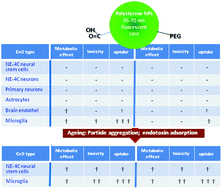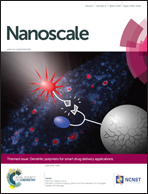Uptake and bio-reactivity of polystyrene nanoparticles is affected by surface modifications, ageing and LPS adsorption: in vitro studies on neural tissue cells†
Abstract
Because of their capacity of crossing an intact blood–brain barrier and reaching the brain through an injured barrier or via the nasal epithelium, nanoparticles have been considered as vehicles to deliver drugs and as contrast materials for brain imaging. The potential neurotoxicity of nanoparticles, however, is not fully explored. Using particles with a biologically inert polystyrene core material, we investigated the role of the chemical composition of particle surfaces in the in vitro interaction with different neural cell types. PS NPs within a size-range of 45–70 nm influenced the metabolic activity of cells depending on the cell-type, but caused toxicity only at extremely high particle concentrations. Neurons did not internalize particles, while microglial cells ingested a large amount of carboxylated but almost no PEGylated NPs. PEGylation reduced the protein adsorption, toxicity and cellular uptake of NPs. After storage (shelf-life >6 months), the toxicity and cellular uptake of NPs increased. The altered biological activity of “aged” NPs was due to particle aggregation and due to the adsorption of bioactive compounds on NP surfaces. Aggregation by increasing the size and sedimentation velocity of NPs results in increased cell-targeted NP doses. The ready endotoxin adsorption which cannot be prevented by PEG coating, can render the particles toxic. The age-dependent changes in otherwise harmless NPs could be the important sources for variability in the effects of NPs, and could explain the contradictory data obtained with “identical” NPs.


 Please wait while we load your content...
Please wait while we load your content...